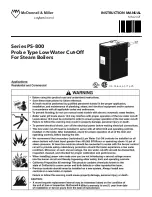
Page 14
LAARS Heating Systems
will require resetting. If a lockout occurs for any of the
reasons stated in this section the “VALVE/FLAME”
light on the boiler control will flash.
Tripouts of the manual reset safety limit can be
caused by a failure of the thermostat in the diverting
valve, short cycling or a calibration change in the
safety limit. If the thermostat in the diverting valve
fails in the closed position, all of the water leaving the
outlet of the primary heat exchanger will be
recirculated back to the inlet and the temperature will
rise rapidly. This rapid temperature rise may cause the
safety limit to trip before the operating control senses
high temperature. Short cycling may cause a tripout in
the same manner. A calibration shift in the safety limit
may also cause it to trip out. If the temperature of the
water leaving the unit is well below 240°F (116°C) and
the recirculation line from the diverting valve to the
pump inlet is not extremely hot the safety limit may be
defective. These same conditions may also indicate a
pump failure, however, knocking generally occurs
when a pump fails.
1X. Routine De-Liming Procedure
ROUTINE DE-LIMING PROCEDURE in hard
water areas. This should be done on a regularly
scheduled basis.
1.
Close the gas cock or manual gas shutoff (see
Figure 9) and shut off the main disconnect switch.
2.
Isolate the HeatMaker 9600 HWG unit from the
system by closing the shutoff valves. If recirc.
lines are piped, isolate the return system from
water heater.
3.
Remove the lower front panel from the water
heater and connect a hose to the drain fitting.
(Located under the cylindrical chamber.) Relieve
pressure at drain.
4.
Connect a hose to the drain (provided by
installer) on the cold (return) side piping to the
appliance.
5.
Remove cover from thermostatic valve and
remove thermostat. Wrap tape around / over
cutaway sections in the cover and replace all
parts except thermostat. Reinstall valve cover and
tighten bolts.
6.
Fill the water heater combustion coil with
deliming solution from the hose connected under
boiler coil assy. until it exits from upper hose. A
small pump should be used to do the filling from
a plastic container. The upper hose should then
be placed in this container and the pump should
run until the circulator solution is no longer
foamy.
7.
Shut off pump and disconnect from hose.
Carefully drain solution from hoses and connect
city water to lower hose to flush combustion coil.
Flush for approximately 5 minutes with city
water.
8.
Remove hoses, close drain cock, close drain on
cold / return, and replace lower front panel .
9.
Remove cover from thermostatic valve and
remove tape. Replace thermostat, spring brass
ring and valve cover, and tighten bolts.
10.
Open shut off valves and purge air from petcock
at top of thermostatic valve cover.
11.
Re-open gas supply and turn on main disconnect
switch to return heater to service.
1Y. Sequence of Operation
On a call for heat from the room thermostat on
9600 CB series boilers, or the tank aquastat on 9600
HWG series, the boiler control is energized through the
control, the vent TCO and the safety limit. It energizes
the pump, checks to ensure that the stack switch
contacts close and the red “PURGE” light lights. The
pump and blower continue to run and for 15 seconds
the red “PURGE” light goes out, the red “igniter” light
lights and the igniter heats for 20 seconds. At the end
of the 20 seconds, the red “VALVE/FLAME’ light is
lit and the gas valve is energized. For 2 seconds the
valve and igniter are energized and burner will ignite.
Following this the igniter is deenergized and the red
“IGNITER” light goes out and the pump and blower
continue to run and the burner operator under the
supervision of the boiler control. If for any reason the
full sequence is completed and the burner doesn’t
ignite, the sequence will be repeated after a blower
“on” time of 45 seconds (30 seconds post purge and 15
seconds prepurge for the next cycle). During this part
of the sequence, the igniter remains on for 30 seconds
and the balance of the sequence is unchanged. If no
ignition occurs again, a third cycle will follow with the
same sequence as the second. After the third “trial for
ignition”, if the burner does not ignite, the system will
“lock out” (valve/flame light flashing) and reset can
only be accomplished by momentarily switching the
power off. At the end of the heating cycle, after the gas
valve is deenergized, the blower will continue to run
for a 30 second post purge and the pump will run for
about another minute. If normal burner operation
during a heating cycle is interrupted by any of the limit
controls the blower will continue to operate for a 30
second post purge and the pump continues to operate
until the call for heat is satisfied.










































